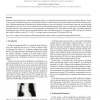Free Online Productivity Tools
i2Speak
i2Symbol
i2OCR
iTex2Img
iWeb2Print
iWeb2Shot
i2Type
iPdf2Split
iPdf2Merge
i2Bopomofo
i2Arabic
i2Style
i2Image
i2PDF
iLatex2Rtf
Sci2ools
105
click to vote
IJON
2010
2010
Modeling radiation-induced lung injury risk with an ensemble of support vector machines
Radiation-induced lung injury, radiation pneumonitis (RP), is a potentially fatal side-effect of thoracic radiation therapy. In this work, using an ensemble of support vector machines (SVMs), we build a binary RP risk model from clinical and dosimetric parameters. Patient/treatment data is partitioned into balanced subsets to prevent model bias. Forward feature selection, maximizing the area under the curve (AUC) for a cross-validated receiver operating characteristic (ROC) curve, is performed on each subset. Model parameter selection and construction occurs concurrently via alternating SVM and gradient descent steps to minimize estimated generalization error. We show that an ensemble classifier with a mean fusion function, 5 component SVMs, and limit of 5 features per classifier exhibits a mean AUC of 0.818 – an improvement over previous SVM models of RP risk. Key words: support vector machine, radiation pneumonitis, feature selection, ensemble learning, unbalanced data
| Added | 28 Jan 2011 |
| Updated | 28 Jan 2011 |
| Type | Journal |
| Year | 2010 |
| Where | IJON |
| Authors | Todd W. Schiller, Yixin Chen, Issam El-Naqa, Joseph O. Deasy |
Comments (0)

